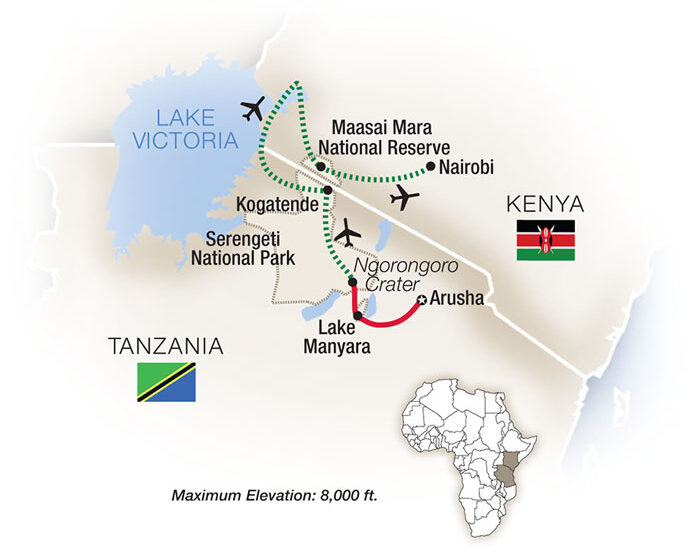Where Is the Serengeti Wildebeest Migration in January?
In January, the Serengeti Wildebeest Migration is concentrated in the Southern Serengeti and the Ndutu Conservation Area, part of the Ngorongoro Conservation Area. This is where the herds gather to prepare for the calving season, which peaks in February.
- Southern Serengeti: The herds graze on the fresh, green grasses of the southern plains, which are rich in nutrients.
- Ndutu Plains: Located in the Ngorongoro Conservation Area, Ndutu is a key region for the wildebeest as they prepare to give birth.
The wildebeest are in the final stages of pregnancy during January, and the herds are scattered across these plains, feeding and building strength for the upcoming calving season.
Serengeti Wildebeest Migration in January: The Calving Season Begins
January marks the beginning of the spectacular calving season in the Serengeti, when over 1.5 million wildebeest gather in the southern plains to give birth. This guide covers everything you need to know about experiencing this remarkable wildlife phenomenon.
Serengeti Wildebeest Migration in January Hotspots
1. Ndutu Region (Southern Serengeti)
Primary calving grounds for wildebeest herds
Lake Ndutu attracts thirsty animals and predators
Open short grass plains perfect for wildlife viewing
2. Kusini Plains
Less crowded alternative to Ndutu
Excellent for cheetah sightings on flat terrain
3. Southern Serengeti Plains
Early arriving herds establishing territories
Beginning of birthing activity (late January)
Wildlife Highlights in January
| Species | Activity | Best Viewing Tips |
|---|---|---|
| Wildebeest | Gathering in southern plains | Look for large herds forming |
| Zebras | Leading the migration south | Scan horizon lines |
| Lions | Establishing territories near herds | Follow woodland edges |
| Cheetahs | Scouting for early newborns | Focus on open plains |
| Hyenas | Beginning to patrol birthing areas | Watch at dawn/dusk |
Serengeti Wildebeest Migration Weather Conditions in January
January falls within the green season in Tanzania, a period of lush landscapes and occasional rain showers. Here’s what you can expect:
- Temperature: Daytime temperatures average around 28°C (82°F), while nights can cool down to about 15°C (59°F).
- Rainfall: January receives occasional afternoon showers, but they are usually short and do not disrupt game drives. The average rainfall is around 80mm (3.1″).
- Landscape: The plains are lush and green, providing a stunning backdrop for wildlife photography.
- Wildlife Visibility: The vegetation is less dense than later in the green season, making it easier to spot wildlife.
Serengeti Wildebeest Migration in January: What to Expect
January is a transitional month for the Serengeti Wildebeest Migration, as the herds settle into the southern plains. Here’s what makes this month special:
Key Highlights:
- Preparation for Calving Season: The wildebeest are in the final stages of pregnancy, and the herds are grazing on the nutrient-rich grasses of the southern plains.
- Lush Landscapes: The rains transform the Serengeti into a green paradise, offering stunning photographic opportunities.
- Abundant Wildlife: While the wildebeest are the main attraction, January is also a great time to see other species, many of which give birth to their young during this time.
- Fewer Crowds: While January is part of the holiday season, the southern Serengeti and Ndutu are less crowded than other popular areas like the Ngorongoro Crater.
Recommended 7-Day Itinerary
Day 1: Arrive Arusha
Day 2-3: Tarangire National Park (elephant herds)
Day 4-6: Ndutu/Southern Serengeti (migration front)
Day 7: Ngorongoro Crater → Depart
Where to Stay in January
Luxury Options
Sanctuary Kusini (exclusive southern location)
Lemala Ndutu (mobile camp near herds)
Mid-Range Camps
Ndutu Safari Lodge (prime calving ground access)
Lake Masek Tented Camp (excellent predator viewing)
Value Choices
Kati Kati Tented Camp (authentic mobile experience)
January Migration Forecast
Early January: Herds consolidating in south
Mid-January: First pregnancies showing
Late January: Initial calving begins
Booking Recommendations
Reserve 6-9 months in advance for best camps
Choose mobile camps that follow herd movements
Consider private guide for optimal wildlife tracking
January vs Other Months
| Month | Advantage | Disadvantage |
|---|---|---|
| January | Calving begins | Fewer newborns |
| February | Peak calving | More visitors |
| December | Herds arriving | Less predictable |
Why January is Unique for Safari Enthusiasts
January offers a unique perspective on the Serengeti Wildebeest Migration Safari, with lush landscapes, pregnant herds, and fewer crowds. It’s a fantastic time to witness the migration in a serene and green setting, away from the busier tourist hotspots.




